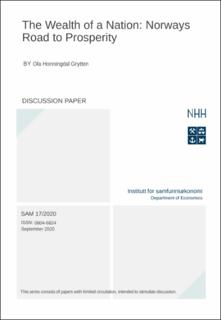| dc.contributor.author | Grytten, Ola Honningdal | |
| dc.date.accessioned | 2020-09-16T09:05:11Z | |
| dc.date.available | 2020-09-16T09:05:11Z | |
| dc.date.issued | 2020-09 | |
| dc.identifier.issn | 0804-6824 | |
| dc.identifier.uri | https://hdl.handle.net/11250/2678016 | |
| dc.description.abstract | The present paper discusses Norway’s way to prosperity during the two last centuries. The main reason for its wealth seems to have been the ability to meet international demand by utilizing its rich natural resources, adopting efficient technology, and draw on a skilled labor force in order to gain high productivity and profitability.
Historical national accounts reveal that Norway’s wealth was close to the western European average in the early nineteenth century. From the 1840s to the mid 1870s, Norwegian growth rates were very high, due to significant growth in foreign trade. This period was followed by relative stagnation until the 1890s, from when the country saw rapid industrialization on the basis of hydroelectricity.
After the two world wars Norway adopted a social democratic rule, with a high degree of economic planning, called the Nordic model. This has contributed to a large public sector and evenly distributed wealth and resources. The discovery of oil and gas on the Norwegian continental shelf marked a new era, when Norway experienced higher growth rates than most western economies. This has made it the country with the highest score in the United Nations Human Development Index (HDI) during the two first decades of the 21st century. | en_US |
| dc.language.iso | eng | en_US |
| dc.publisher | Institutt for samfunnsøkonomi | en_US |
| dc.relation.ispartofseries | DP SAM;17/2020 | |
| dc.subject | Economic history, economic growth, economic development, Norway. | en_US |
| dc.title | The Wealth of a Nation: Norways Road to Prosperity | en_US |
| dc.type | Working paper | en_US |
| dc.subject.nsi | Samfunnsvitenskap | en_US |
| dc.source.pagenumber | 34 | en_US |
